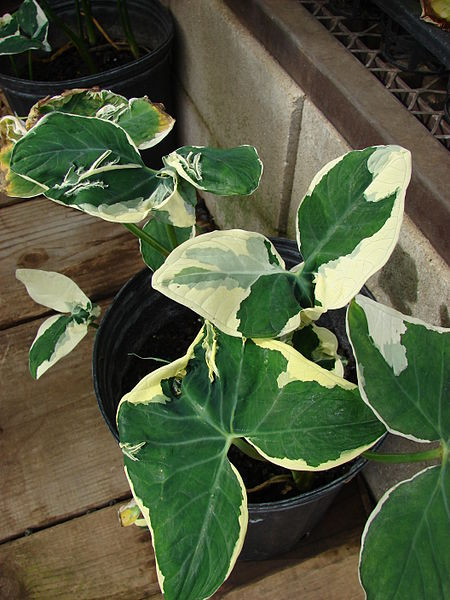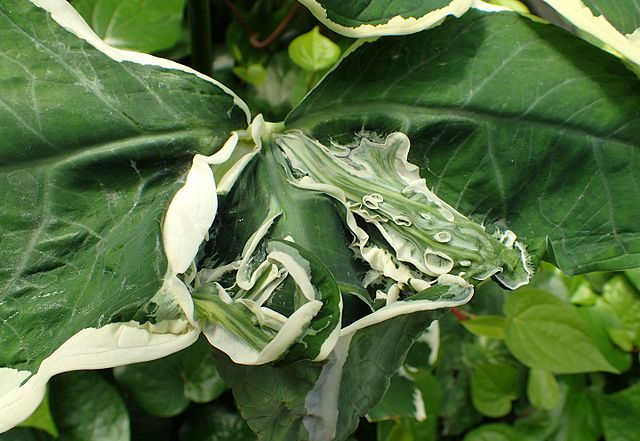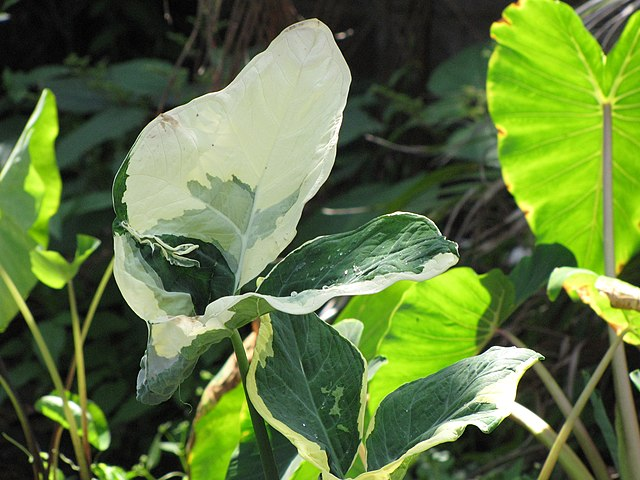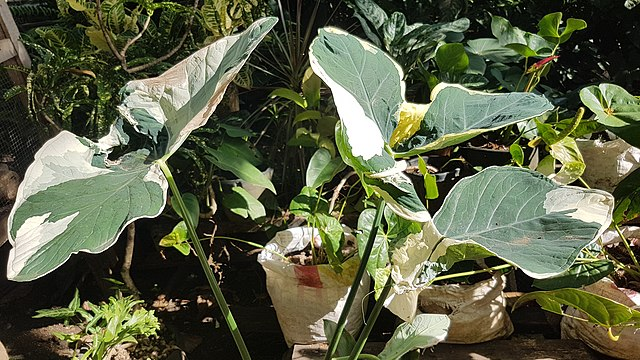Want to add a dash of nostalgia and exquisite beauty to your gardens? Today, we present you with another beautiful aroid that comes straight from your childhood, the Alocasia Mickey Mouse plant. The large dark-green foliage and light green to cream variegation spread on a very familiar leaf shape (nothing to do with Disney at all!) will make any space alive and vibrant.
Keep reading this care and information guide to know more about this superbly exciting and beautiful plant perfect for your outdoor and indoor scaping.

Alocasia Mickey Mouse Profile
General Information
Mickey Mouse Alocasia is a popular member of the Aroids family due to the familiar shape of the leaves and its distinct foliage pattern. The deep green leaves shaped like an elephant ear with unique light green to cream variegation are huge. In addition, the variegations of this plant are unique from each other; thus, no two leaves are similar.
The popular indoor plant has a confusing lineage. Although it is known as Mickey Mouse Alocasia, it is not an Alocasia. It is under the genus Xanthosoma, which is closely related to Alocasia. They are probably misidentified because of the close resemblance between the two genera under the same family.
Etymology
The common name “Mickey Mouse” is due to the attractive shape of the leaf blade of this plant, which closely resembles the famous Disney character of the same name, Mickey Mouse. The Mickey Mouse Alocasia is also known as Mickey Mouse Taro, Mouse Cup, and Pocket Plant.
The genus Xanthosoma is derived from the Greek words Xanthos and Soma. Xanthos means “yellow”, while Soma means ‘body”. Yellow refers to the inner coloration of the plant tissues.
Flowering
The Mickey Mouse Taro has a similar flower type as your Alocasias. They have spadix inflorescence, which is cream or off-white. They flower a few times a year. However, this is seldom, and the flowering season is unreliable.
Season Of Interest And Purchasing
The Mickey Mouse Taro, like your Alocasias, actively grows during spring and summer. It originates from tropical climates, so they go into dormancy during the winter season. They are commercially available all year round since they are fast-growing and easy to propagate house plants. This is not a rare plant.
Growth
Mickey Mouse Alocasia are fast-growing house plants. They grow for a maximum of 6 feet tall, with a mature spread of about 5 feet. However, indoors they are relatively smaller. For example, a well-cared indoor Mickey Mouse Taro can only grow up to 3-5 feet tall.
Alocasia Mickey Mouse Overview
| Scientific name | Xanthosoma sagittifolium ‘Variegatum Monstrosum” |
| Common name/s | Mickey Mouse Alocasia, Mickey Mouse Taro, Mouse Cup, Pocket Plant |
| Family | Araceae |
| Growth Habit | Herbaceous |
| Height and Spread | 1 – 1.5 meters tall |
| Classification based on life cycle | Perennial |
| Origin and Distribution | Native origin to tropical America |
| Climate Zone | Generally warmer climate |
| USDA Plant Hardiness Zone | USDA Zone 9 – 11 |
| Color | Shiny dark-green foliage with light to cream variegations |
RELATED: What Type of Pothos Do I Have? Let Us Solve the Puzzle!
Care Tips

Light Requirement
The Mickey Mouse Alocasia loves plenty of bright light, which is indirect light. The leaves of this Mickey Mouse taro could not tolerate direct sunlight as it has poor resistance to it. Thus, placing them in an excellent position is essential to avoid scorching the leaves. A well-lit sunny window corner is a perfect spot for Mickey Mouse Alocasia.
The same conditions should be applied when planted outdoors. Alocasia likes bright light, but too much direct light will burn the leaves. The perfect growing zone is still with indirect sunlight. Since they benefit from a partial shade environment, they can also grow near specific growing zones that fruit trees have.
Temperature Requirement
Aroids have an ideal optimum range of about 54 – 85 degrees Fahrenheit. This is also true of Xanthosomas, including the Mickey Mouse species. The temperature range is simply the comfortable room temperature. This makes Mickey Mouse plants good and easy indoor house plants.
The plants in the genus Xanthosoma, just like Alocasia, have poor resistance to cold temperatures, as they originated from tropical climates. Below the optimum range temperature, the plant gets frozen or killed. Therefore, it is essential to bring this plant indoors before the fall season in temperate countries.
Water Requirement
The most common and effective water strategy for Alocasias and Xanthosomas care is to water the soil thoroughly and wait for the upper 3 inches of the topsoil to dry off completely before the following watering schedule. Through this strategy, overwatering and underwatering problems are mitigated.
During the autumn and winter season, the watering needs of Xanthosomas become minimal because the plant undergoes a dormancy period. Therefore, avoid watering the plant more than once every three weeks in these seasons.
Humidity Requirement
Mickey Mouse Taro is a tropical plant that loves appropriate amounts of warmth and humidity. Because of its native origin, the ideal moisture level that this plant needs is 80% and above, emulating a tropical environment. An average moisture level is also suitable for this plant to achieve healthy growth.
When you are situated in a dry zone, you can still grow this plant, provided a little effort is ensured to achieve the optimum humidity level. Several ways can be done to increase humidity, such as misting using a spray bottle and putting a pebble tray with water below the plants. Also, ensure to place them in a place with good aeration to avoid sogginess.
Soil Requirement
The Mickey Mouse Alocasia needs rich and well-draining soil to thrive. The potting soil must have proper drainage and aeration to avoid root rotting and to maintain the soil’s moisture level. A standard jungle mix or a commercially available aroid mix will do for this plant.
Fertilizer Requirement
The Mickey Mouse Taro, with its sizeable ear-shaped foliage, is a food-loving plant that gulps on fertilization. Once a month of high-quality fertilization is recommended during spring and summer’s growing seasons.
However, overfertilization is also detrimental to plants, just like overwatering. Therefore, it is essential to dilute the concentration in half to avoid harming the plant. During the end of the summer season, no fertilization is needed until winter.
Space Requirement
The Mickey Mouse Taro does not need ample space to grow well. It can grow in pots with suitable drainage holes and small spaces. It is an excellent indoor houseplant that could fit into any corner of your home.
Growing And Planting Tips
Propagation
The propagation of Mickey Mouse Alocasia is relatively easy. The recommended method of propagation, and proven to be the most successful, is through division. Planting is encouraged during the growing season.
Choose your healthy mother plant and carefully dig it up from the soil to not destroy the roots to propagate using this method. Next, cut the pups around the mother plant using a sterile knife or sharp object. A cutter or blade will also do. Always make sure to avoid inflicting damage to the roots.
Once the pups are separated from the mother plant, please place them in a pot with the proper growing medium in a good growing zone. Avoid heavy watering during the first month to aid in good rooting. Also, avoid placing them in the direct sun.
After the first month, you can employ the proper care mentioned in the last part for the new plants. You can have a new plant after a month.
Pruning
There is no need for a regular pruning of this plant. However, to keep the fresh look of the plant, remove dead or damaged foliage carefully. Removing and pruning dead leaves also encourage healthy growth and new foliage.
Potting And Repotting

This Mickey Mouse Alocasia does not need frequent re-potting. You can just relax and enjoy the magnificence of its beauty and wait it outgrows its pot. When it finally does, better choose a pot that is double the size of the original one. Mickey Mouse Taro is a relatively fast-growing plant.
Always use the proper growing medium for this Mickey Mouse Alocasia when you re-pot. Add coir fiber and perlite to the organic soil mix to enhance drainage and aeration. On the other hand, you can substitute coir fiber with peat moss if it is not available.
Alocasia Mickey Mouse Care
| Light | Bright indirect |
| Temperature | 54 – 85 degrees Fahrenheit |
| Water | Once a week, increased in summer, decreased in winter |
| Soil | Well-draining and rich |
| Fertilization | Once a month, no fertilization needed in winter |
| Space | Minimal space |
| Propagation | Via rhizome division |
| Blooming | Rarely blooms, enough sunlight and maturity needed |
| Pruning | When needed, removal of damaged and decaying leaves |
| Potting | Regular potting mix or Aroid mix, use of coco fiber, perlite and peat moss recommended |
RELATED: Alocasia Maharani: Helpful Plant Information and Care Guide For This Rare Beauty
Pests And Diseases
Alocasia Mickey Mouse Pests And Diseases
| Common Pests/Diseases | Symptoms | Treatment and Prevention |
Common diseases include leaf spotting, root rotting, fungal diseases, stem and crown rotting. | Black or dark brown spots with yellow rim around | Do not overwater and maintain proper humidity levels. Extremely wet environments enhance fungal growth.Proper ventilation is necessary. Removal of infected plant parts to avoid spreading of disease. |
| Common pests include aphids, scales, mealybugs, spider mites | Visible insects thriving on surface | Warm, soapy water can be sprayed once a month. Neem oil, herbal spray, or commercial insecticides can also be used. |
Problems And Troubleshooting
Overwatering
Overwatering symptoms of tropical plants are generally observed in their roots and leaves. It is a big sign of overwatering if you see a general drooping of the leaves. Wet feet and yellowing leaves are also commonly observed, as well as water blisters, edema, and prominent brown spotting on surfaces of leaves. In worst-case scenarios, root rotting can happen.
To avoid overwatering, ensure that the watering schedule of your Mickey Mouse Taro is proper and correct. Check the soil before deciding to water the plant. Also, ensure that the plant gets the minimum requirements such as well-draining soil, bright indirect light, and humidity.
Furthermore, do not plant it in a large pot and ensure that drainage holes are correctly working. Instead, add peat moss and coco coir to your potting soil to improve drainage and aeration. This helps avoid soggy soil conditions, which will lead to root rot if not remedied.
Underwatering
It is easier to observe underwatering symptoms in most plants than overwatering symptoms. Generally, brown edges and crispy tips are excellent indicators of underwatering problems. A cracky upper soil is also a great sign that your plant needs watering.
To avoid this, ensure that proper watering frequency is followed for your plant. Make sure to water 2-3 times weekly during summer. Alocasia likes a moist environment. If the plant already outgrows its pot, more watering is needed as the plant efficiently uses the water. Re-pot it to a pot more significant than its original container, about twice the width.
Take account of the type of light the plant receives. Direct sunlight also contributes to the fast evaporation of water, thus making the soil dry. Always make sure to put them in proper growing zones.
Nutrient Deficiency

Nutrient deficiency symptoms observed in this plant include yellowing of leaf surfaces, crispy edges, leaf holes and burns, brown tips, purplish hues on the leaves, and distorted growth of roots. These symptoms are also seen in other plants. If your plant shows either one or more of these symptoms, it could signify that feeding is needed.
Use a high-quality and complete fertilizer for your Mickey Mouse Alocasia. Use proper strength as too concentrated fertilizer could burn the plant. Generally, a half-strength fertilizer is given. Always make sure to keep the soil pH at its optimum as it dramatically affects the absorption of nutrients by the plants.
Flowering Problems
To ensure that your plants produce flowers when they can, give sufficient lighting to the plant. The amount of light is crucial for Alocasia and Xanthosoma plants to flower successfully, so you must place them in the proper growing zone.
Problems With People And Animals
Toxicity
Like your Alocasias, Xanthosomas have calcium oxalate crystals in their leaves and stems. These crystals can induce swelling and irritation in the throat and mouth when ingested. Both humans and animals can be affected by these crystals. In worst-case scenarios, these irritations and swellings can cause airway blockage and eventually death.
Alocasia Plants Meaning And Symbolism

Even though they are not trees, the Alocasia plants are said to be the “trees that grow up to the heavens”, as mentioned in the famous fairytale “Jack and the Beanstalk”. With this, the Mickey Mouse Taro symbolizes taking risks and seizing opportunities. Therefore, these Alocasia plants are great gifts for people about to make significant life decisions.
Alocasia Mickey Mouse Symbolism And Meaning
| General Meaning | “plant that grows up to heavens” |
| Symbolism | Risk taking and seizing opportunities |
| Cultural Significance | Attribution to the Jack and the Beanstalk fairytale |
Landscaping And Gardening Ideas
Companion Plants
Other indoor patio plants with elephant-ear-shaped large leaves such as Caladiums, Colocasia, Alocasias, and other Xanthosomas are great companion plants of Mickey Mouse Alocasia. These plants provide a bold look to your landscape, adding to the tropical vibe you are aiming for.
These plants’ mesmerizing deep green leaves and the interesting pattern and coloration add dramatic contrast to your spaces. In addition, the Mickey Mouse Taro combines well with other tropical house plants such as Canna Lilies, Ornamental Bananas, Ficus, Dieffenbachia, Schefflera, Coleus, and Castor Beans.
Landscaping Ideas
Mickey Mouse Taro plants provide contrast in texture with typical bedding plants, ornamental grasses, and ferns in gardens. You can pair this with any dark-leaved varieties, orange or yellow flowering patio plants to provide a more vibrant contrast. They can offer an excellent focal point for any site when planted with low-growing annuals, such as your petunias.
Mickey Mouse Taro’s huge foliage and other plants with large leaves act as privacy shrubs in your homes.
| What to plant with | Colocasia, Caladiums, Alocasias, Xanthosomas, Coleus, Canna Lilies, Ornamental Bananas, Ficus, Dieffenbachia, Schefflera, Castor Beans, Low-lying annuals, Ferns |
| What NOT to plant with | Basically nothing |
Conclusion

The Mickey Mouse plant is one of the must-have house plants because of its relatively easy care and undeniable beauty. It is not a rare plant, but it is so unique that no two leaves are similar in this plant due to its irregular variegations. However, it must always be kept in mind that this beauty is toxic for both us humans and animals.
FAQS
1. Is Mickey Mouse plant rare?
The Mickey Mouse plant is not a rare house plant. It is common and popular in the US.
2. Is Mickey Mouse an Alocasia or Caladium?
Neither. The Mickey Mouse plant is a member of the genus Xanthosoma. The three genera, Alocasia, Caladium, and Xanthosoma are members of the Aroid family, Araceae, hence the close resemblance and confusion.
3. How often should you water a Mickey Mouse plant?
It is important to water the plant when the soil is completely dry. To check, dip a stick or your finger in the first 3 inches of topsoil. If it is still moist, skip watering. Allow the soil to be completely dry.
As a general rule, water the plant once a week. In summer, increase it as needed.
4. Does the Mickey Mouse plant bloom?
As an angiosperm, Mickey Mouse plants produce flowers similarly looking to your Alocasia flowers. However, there is no reliable flowering season as they rarely flower.
5. Does Xanthosoma go dormant?
Yes, like your Alocasias, Xanthosomas go dormant when the temperatures go low. In early fall to winter, the Xanthosomas undergo dormancy.
Did you like this Alocasia Mickey Mouse article? Comment below. Also, check out our other articles:
Snake Plant Roots: What To Look For In A Healthy Sansevieria Plant
Snake Plant Problems: Common Sansevieria Problems and How To Fix Them
Monstera Laniata Vs. Adansonii: Differences Between The Two Monsteras







